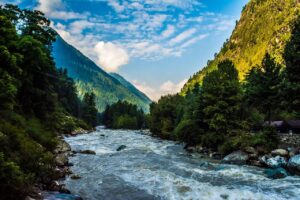Overview
Nestled in the heart of the Garhwal region of Uttarakhand, India, the Kedarkantha trek is a bewitching journey that beckons adventurers and nature enthusiasts alike. This trek is a gateway to the mesmerizing grandeur of the Himalayas, offering a unique blend of challenges and rewards. At an altitude of approximately 12,500 feet (3,800 meters), it provides a captivating experience without the extreme rigors associated with high-altitude treks. Kedarkantha’s allure lies in its diverse terrain. It guides trekkers through dense alpine forests adorned with rhododendron blooms, pristine meadows carpeted with wildflowers, and stretches of snow-clad trails that sparkle under the sun. This trek offers a symphony of natural beauty that changes with the seasons, making it a year-round adventure.
As you ascend, the sight of majestic Himalayan peaks unfolds before your eyes, painting an indelible picture of nature’s grandeur. The Kedarkantha trek’s moderate difficulty level welcomes trekkers from various backgrounds, promising an unforgettable experience and memories etched against a backdrop of Himalayan splendor. Join us on a journey to unravel the magic of Kedarkantha, where the mountains whisper their secrets, and every step is a step closer to nature’s embrace. However, like any adventure in the mountains, it comes with its own set of challenges and rewards.
About theTrek
The Kedarkantha trek is a moderate trek, making it suitable for both beginners and experienced trekkers. It is typically completed in 5 to 6 days and covers a distance of approximately 20 kilometers, starting from Sankri, a picturesque village in the Uttarkashi district. One of the key factors that determine the difficulty level of a trek is the terrain and weather conditions. The Kedarkantha trek takes you through a variety of landscapes, including dense pine forests, snow-clad trails, and open meadows.
During the first portion of the hike, you’ll be walking through thick pine and oak woodlands. Although the routes are clearly marked, you could run into some steep ascents and descents. You can come across snow on the trail depending on the season, particularly during the winter. While snow enhances the trek’s attractiveness, it can also make the terrain more difficult. At the summit of Kedarkantha, you reach a height of around 12,500 feet (3,800 metres) through the hike. One of the possible factors is altitude, and some hikers might have moderate altitude sickness symptoms. The right acclimatisation is essential. In the Himalayas, the weather can change suddenly. Even in the summer, nighttime temperatures can drastically drop. Be ready for the cold, particularly at higher altitudes.
Things to know before trek
A moderate level of physical fitness is needed for the trek. Although it is appropriate for novices, it is necessary to be in excellent health and have some past experience with trekking. You can better prepare your body for the rigours of the walk by engaging in regular cardiovascular and strength training workouts. As was already noted, some hikers may find the altitude to be difficult. The risk of altitude sickness can be reduced by allowing time for acclimatisation and drinking plenty of water. In the highlands, the weather is subject to sudden changes. Even in the summer, hikers must be ready for chilly weather and potentially challenging situations. Proper clothing, including layers, insulated jackets, and waterproof gear, is essential. The trek spans several days, with daily trekking durations ranging from 4 to 6 hours. Stamina and endurance are important, especially for longer days on the trail. Carrying a backpack with your essentials can add to the physical challenge. It’s crucial to pack wisely, carry only what you need, and distribute the weight evenly in your backpack.
Despite the challenges, the Kedarkantha trek offers numerous rewards that make it a memorable and fulfilling experience. The summit of Kedarkantha offers panoramic views of some of the most famous Himalayan peaks, including Swargarohini, Bandarpoonch, and Black Peak. The sight of these majestic mountains is a reward in itself. Along the way, you’ll have the opportunity to interact with the locals in the villages of Sankri and Juda Ka Talab. This provides a unique cultural experience and a chance to learn about the traditional way of life in the mountains. The trek takes you through diverse ecosystems, allowing you to witness a variety of flora and fauna. Keep an eye out for Himalayan birds and the occasional glimpse of wildlife. Completing the Kedarkantha trek is a remarkable achievement. Standing at the summit, surrounded by snow-clad peaks, you’ll feel a profound sense of accomplishment and a connection with nature.
Conclusion
The Kedarkantha trek, with its stunning landscapes and unique challenges, is a remarkable adventure for trekkers of varying experience levels. While it may pose some difficulties, careful preparation, physical conditioning, and a love for the outdoors will help you conquer this beautiful trail. The rewards, including breathtaking views and a sense of accomplishment, make the journey more than worth the effort. So, lace up your trekking boots, prepare your backpack, and get ready to embark on an unforgettable adventure in the Himalayas.

